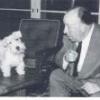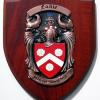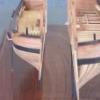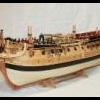MORE HANDBOOKS ARE ON THEIR WAY! We will let you know when they get here.
×
-
Posts
1,197 -
Joined
-
Last visited
Reputation Activity
-
 Stuntflyer reacted to BobF in 18th Century Longboat by BobF - FINISHED - Model Shipways - 1:48 - Tri-Club
Stuntflyer reacted to BobF in 18th Century Longboat by BobF - FINISHED - Model Shipways - 1:48 - Tri-Club
Erik,
Thanks, but I'll tell you a secret. I keep the camera slightly out of focus. That hides a lot of flaws.
The bow modifications will be the last kit bashing I do on this model. I get a lot of grief from my fellow club members about how long I've been working on this longboat. It's definitely time to get it in a case!
BobF
-
 Stuntflyer got a reaction from Martin W in Cutter Cheerful 1806 by rafine - FINISHED
Stuntflyer got a reaction from Martin W in Cutter Cheerful 1806 by rafine - FINISHED
A milestone for sure, Bob. It really does look great with all the deck fittings in place. Looking forward to your posts on rigging.
-
 Stuntflyer got a reaction from Canute in Cutter Cheerful 1806 by rafine - FINISHED
Stuntflyer got a reaction from Canute in Cutter Cheerful 1806 by rafine - FINISHED
A milestone for sure, Bob. It really does look great with all the deck fittings in place. Looking forward to your posts on rigging.
-
 Stuntflyer got a reaction from mtaylor in Cutter Cheerful 1806 by rafine - FINISHED
Stuntflyer got a reaction from mtaylor in Cutter Cheerful 1806 by rafine - FINISHED
A milestone for sure, Bob. It really does look great with all the deck fittings in place. Looking forward to your posts on rigging.
-
 Stuntflyer got a reaction from GLakie in Cutter Cheerful 1806 by rafine - FINISHED
Stuntflyer got a reaction from GLakie in Cutter Cheerful 1806 by rafine - FINISHED
A milestone for sure, Bob. It really does look great with all the deck fittings in place. Looking forward to your posts on rigging.
-
 Stuntflyer reacted to Chuck in Cutter Cheerful 1806 by rafine - FINISHED
Stuntflyer reacted to Chuck in Cutter Cheerful 1806 by rafine - FINISHED
That does look wonderful all fitted out.....really good stuff. Looking forward to the rigging stage!!
-
 Stuntflyer reacted to KenW in Rattlesnake by KenW - FINISHED - Model Shipways - Scale 1:64 - American Privateer
Stuntflyer reacted to KenW in Rattlesnake by KenW - FINISHED - Model Shipways - Scale 1:64 - American Privateer
Now the head is truly finished. The bow sprint with its gammoning, the ‘seats of ease’, and the platform are complete. I do plan on making a hand railing, but I want to wait until the rigging is done so I can insure that the railing doesn’t foul the lines. So, for now, my plan is to move aft with the installation of the last 4 guns.
-
 Stuntflyer reacted to dvm27 in Greenwich Hospital barge of 1832 by druxey - FINISHED - 1:48 scale
Stuntflyer reacted to dvm27 in Greenwich Hospital barge of 1832 by druxey - FINISHED - 1:48 scale
Don't believe it, Maury. I've visited Druxey's workshop and you could do surgery there!
-
 Stuntflyer got a reaction from dgbot in Greenwich Hospital barge of 1832 by druxey - FINISHED - 1:48 scale
Stuntflyer got a reaction from dgbot in Greenwich Hospital barge of 1832 by druxey - FINISHED - 1:48 scale
This is definately a first for me Druxey. I have never had the pleasure of following any of your build logs. Let's just say that I'm very excited to see this one.
Mike
-
 Stuntflyer reacted to Gahm in US Brig Syren by Gahm - Model Shipways
Stuntflyer reacted to Gahm in US Brig Syren by Gahm - Model Shipways
After getting distracted by a lot of other (mostly business related) projects I finally found some time to resume work on my Syren. Now the long gun prototypes, which I have shown on my model during the last 2 years, need to be replaced with the final versions. As there are only 2 guns I decided to make the gun barrels myself based on Chuck’s Syren plans. Images 1a – 1d show the different steps of turning one of the gun barrels. In image 2e the trunnion holes are drilled. After a “sanity check” with one of the gun carriages from the Syren kit the barrel is separated from the raw metal piece and the gun muzzle finished (img 2g). Img 3a shows the barrel with trunnions in place, the locations for the breech ring and touch-hole parts milled out, and the parts lying beside the barrel. The assembled gun barrel and Chuck’s plans are depicted in images 3b and 3c. The final result after blackening can be seen in image 4.
Thomas
Image 1
Image 2
Image 3
Image 4
-
 Stuntflyer reacted to BobF in 18th Century Longboat by BobF - FINISHED - Model Shipways - 1:48 - Tri-Club
Stuntflyer reacted to BobF in 18th Century Longboat by BobF - FINISHED - Model Shipways - 1:48 - Tri-Club
Here are a few photos of the modified bow. The thole pins have also been installed. For the pins, I used small quantities of five minute epoxy to glue them in place. This gave me time to align them and make sure they were at a uniform height.
BobF
-
 Stuntflyer got a reaction from Captain Poison in HM Cutter Cheerful 1806 by Stuntflyer (Mike) - FINISHED - 1:48 scale
Stuntflyer got a reaction from Captain Poison in HM Cutter Cheerful 1806 by Stuntflyer (Mike) - FINISHED - 1:48 scale
I started lining off the deck today. . .
Using a tick strip, the deck beam reference line on the fore side of the main hatch was divided into equal segments. Mine needed eleven, each segment being slightly under 3/16". I divided the eleven spaces into two belts seven inner and four outer.
To establish the two belts down the length of the hull I decided to get the initial curve from the plan and adjust it later if needed on the deck itself. I had already made a copy of the plan sheet showing the deck. I made a few changes to the plan to correspond to the actual build. I placed a thin sheet of glass over the plan and used a ships curve and a fine line marking pen to draw the curve. Once I was satisfied with the run of the curve I placed 1/8" tape along the line directly to the glass.
A photo was taken and printed so the curve could be glued to card stock. Placing the curve on the deck showed that only a slight adjustment was needed at the location of the tick mark which divides the two belts. With the curve redrawn and a line transferred to both sides of the deck, I was ready to complete the remaining tick marks. Connecting the tick marks really helps to see what the run of planks will look like. In a few places I included the planks tab into the measurments and that was enough to throw off the even flow of planks down the hull. If I had not connected the tick marks it would have been very difficult to spot these errors.
Mike
-
 Stuntflyer got a reaction from PeteB in HM Cutter Cheerful 1806 by Stuntflyer (Mike) - FINISHED - 1:48 scale
Stuntflyer got a reaction from PeteB in HM Cutter Cheerful 1806 by Stuntflyer (Mike) - FINISHED - 1:48 scale
Planking the deck is not exactly what I would call a milestone though it does feel like I'm moving along. . .
Though not very scientific, I did come up with a way to get those center planks in a straight line. After setting the first plank at the stern I used a card template at each location along the deck to keep the planks straight. To confirm alignment, I marked the center of the plank at its forward edge as well as the aft edge of the deck structure. After pulling the plank to the card template I could see whether or not two marks matched closely
The four remaining planks (two on each side of center plank) where then installed using PVA and clamps. I was careful not to glue anywhere close to the red deck structures. Scrap strips were used between the clamp and the deck planking to avoid any dents that might be caused from tightening of the clamps. I don't have any of those high-tech wooden clamps like those used by EdT though the ones from Dewalt (found at Home Depot) worked well enough. The clamp's protective covers were removed in order to get a better grip on the planks. The Irwin Quick-Grips have a more rounded shape underneath the covers and tend to slip off too easily.
My deck planks are approximately 3/16" wide and in various locations will have a small tab. These have to be made using a wider strip. I tried making one that would have been 7/32" at its widest point using a 7/32" strip. Guess what, it didn't work. There wasn't enough room to allow for adjustments to the shape. I decided to go with a 1/4" strip, which worked quite well. Once the shape was completed it was only a matter of reducing the width to 3/16" outside of the tab location. This is an important step if you want to maintain consistency to the overall look of the planking.
This is the plank which goes on either side of the "ventilation scuttle grating", just behind the skylight.
Once the first five rows were completed, excess glue was removed and the planks were lightly sanded. I will hold off doing the final sanding until all of the remaining planks are in.
-
 Stuntflyer got a reaction from Bobstrake in Greenwich Hospital barge of 1832 by druxey - FINISHED - 1:48 scale
Stuntflyer got a reaction from Bobstrake in Greenwich Hospital barge of 1832 by druxey - FINISHED - 1:48 scale
This is definately a first for me Druxey. I have never had the pleasure of following any of your build logs. Let's just say that I'm very excited to see this one.
Mike
-
 Stuntflyer reacted to BobF in 18th Century Longboat by BobF - FINISHED - Model Shipways - 1:48 - Tri-Club
Stuntflyer reacted to BobF in 18th Century Longboat by BobF - FINISHED - Model Shipways - 1:48 - Tri-Club
JS:
If you go back to my post #178, you'll see a photo of a contemporary model that happens to have the pulley at the bow. Although not quite as clear, you can also see that the starboard side seems to have the same shaped piece with no pulley. Could it have been for the sake of symmetry, or did it provide additional support for the bowsprit?
BobF
-
 Stuntflyer reacted to JSGerson in 18th Century Longboat by BobF - FINISHED - Model Shipways - 1:48 - Tri-Club
Stuntflyer reacted to JSGerson in 18th Century Longboat by BobF - FINISHED - Model Shipways - 1:48 - Tri-Club
Thanks Bob, I did see that photo before but I never noticed the pulley.
-
 Stuntflyer got a reaction from Canute in Cutter Cheerful 1806 by Rustyj - FINISHED - 1:48 Scale
Stuntflyer got a reaction from Canute in Cutter Cheerful 1806 by Rustyj - FINISHED - 1:48 Scale
Great to see you building again Rusty. I've had a great time building Cheerful and I'm sure that you will too. Please keep those photos coming.
Mike
-
 Stuntflyer reacted to wyz in HM Cutter Cheerful 1806 by Erik W - 1:48 scale
Stuntflyer reacted to wyz in HM Cutter Cheerful 1806 by Erik W - 1:48 scale
Kit or scratch? Who knows? I might call it a hybrid build, but regardless of what term used you are off to a great start. Tools? Well, once you catch the bug, and I suspect you're already "infected", you will always want more of them. Erik, there is no cure! ;-)
Tom
-
 Stuntflyer got a reaction from Canute in HM Cutter Cheerful 1806 by Engelmann - 1:48 - POB
Stuntflyer got a reaction from Canute in HM Cutter Cheerful 1806 by Engelmann - 1:48 - POB
Great start Deon,
I will be following. . .
Mike
-
 Stuntflyer got a reaction from Erik W in Cutter Cheerful 1806 by Rustyj - FINISHED - 1:48 Scale
Stuntflyer got a reaction from Erik W in Cutter Cheerful 1806 by Rustyj - FINISHED - 1:48 Scale
Great to see you building again Rusty. I've had a great time building Cheerful and I'm sure that you will too. Please keep those photos coming.
Mike
-
 Stuntflyer got a reaction from mtaylor in HM Cutter Cheerful 1806 by Engelmann - 1:48 - POB
Stuntflyer got a reaction from mtaylor in HM Cutter Cheerful 1806 by Engelmann - 1:48 - POB
Great start Deon,
I will be following. . .
Mike
-
 Stuntflyer got a reaction from Rustyj in Cutter Cheerful 1806 by Rustyj - FINISHED - 1:48 Scale
Stuntflyer got a reaction from Rustyj in Cutter Cheerful 1806 by Rustyj - FINISHED - 1:48 Scale
Great to see you building again Rusty. I've had a great time building Cheerful and I'm sure that you will too. Please keep those photos coming.
Mike
-
 Stuntflyer reacted to Engelmann in HM Cutter Cheerful 1806 by Engelmann - 1:48 - POB
Stuntflyer reacted to Engelmann in HM Cutter Cheerful 1806 by Engelmann - 1:48 - POB
Hi
A small update. I have started on my Cheerful
First off joined the two false keel pieces taking care to get everything as straight as I could.
I used yellow wood glue.
After leaving it for a couple of hours for the glue to cure, I cleaned up the joint and did a test fit of the bulkheads.
I've made some cutouts in the false keel between bulkheads 6 and 14 and in bulkheads 8, 10 and 12 to make some space for the command cabin and the gun room.
The command cabin is under the skylight and the gun room is under the companionway.
I want to build my companionway with it's doors and top hatch open.
I'm not sure how much will be visible through the skylight and companionway so it might just be a planked deck or there might be some extra details, will still decide on it.
Cheers
Deon
-
 Stuntflyer got a reaction from mtaylor in Cutter Cheerful 1806 by Rustyj - FINISHED - 1:48 Scale
Stuntflyer got a reaction from mtaylor in Cutter Cheerful 1806 by Rustyj - FINISHED - 1:48 Scale
Great to see you building again Rusty. I've had a great time building Cheerful and I'm sure that you will too. Please keep those photos coming.
Mike
-
 Stuntflyer reacted to Erik W in HM Cutter Cheerful 1806 by Erik W - 1:48 scale
Stuntflyer reacted to Erik W in HM Cutter Cheerful 1806 by Erik W - 1:48 scale
A couple of quick grab shots. I tested the smoothness of my fairing job by temporarily fastening a batten strip at various positions on the hull. It's smooth!
Erik












